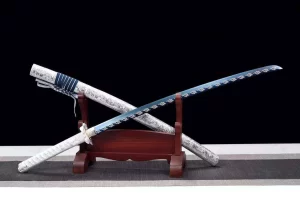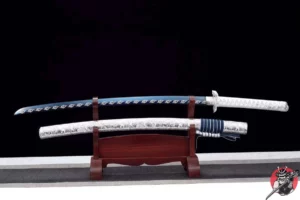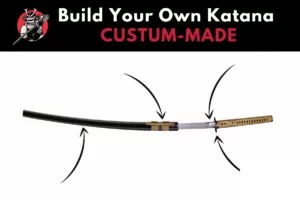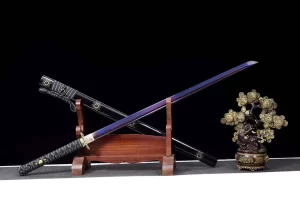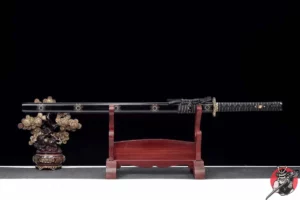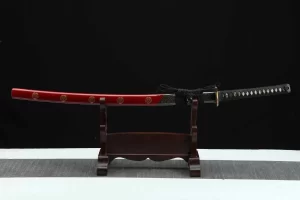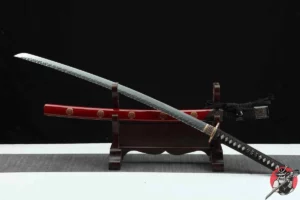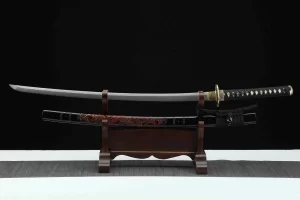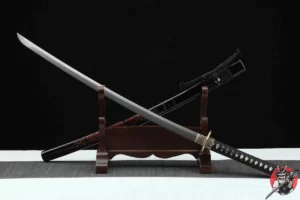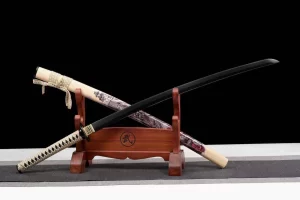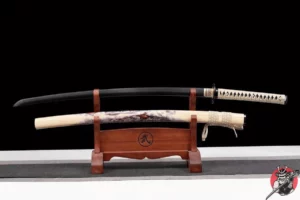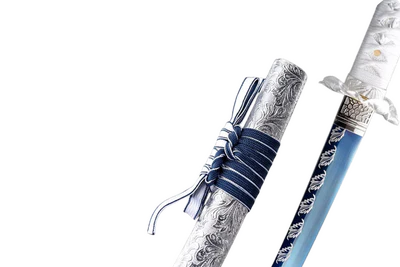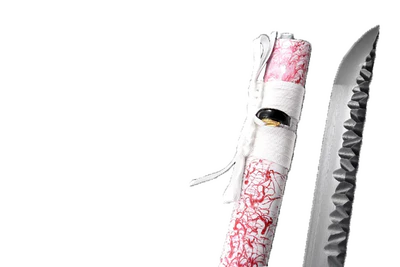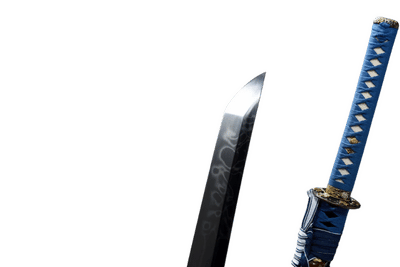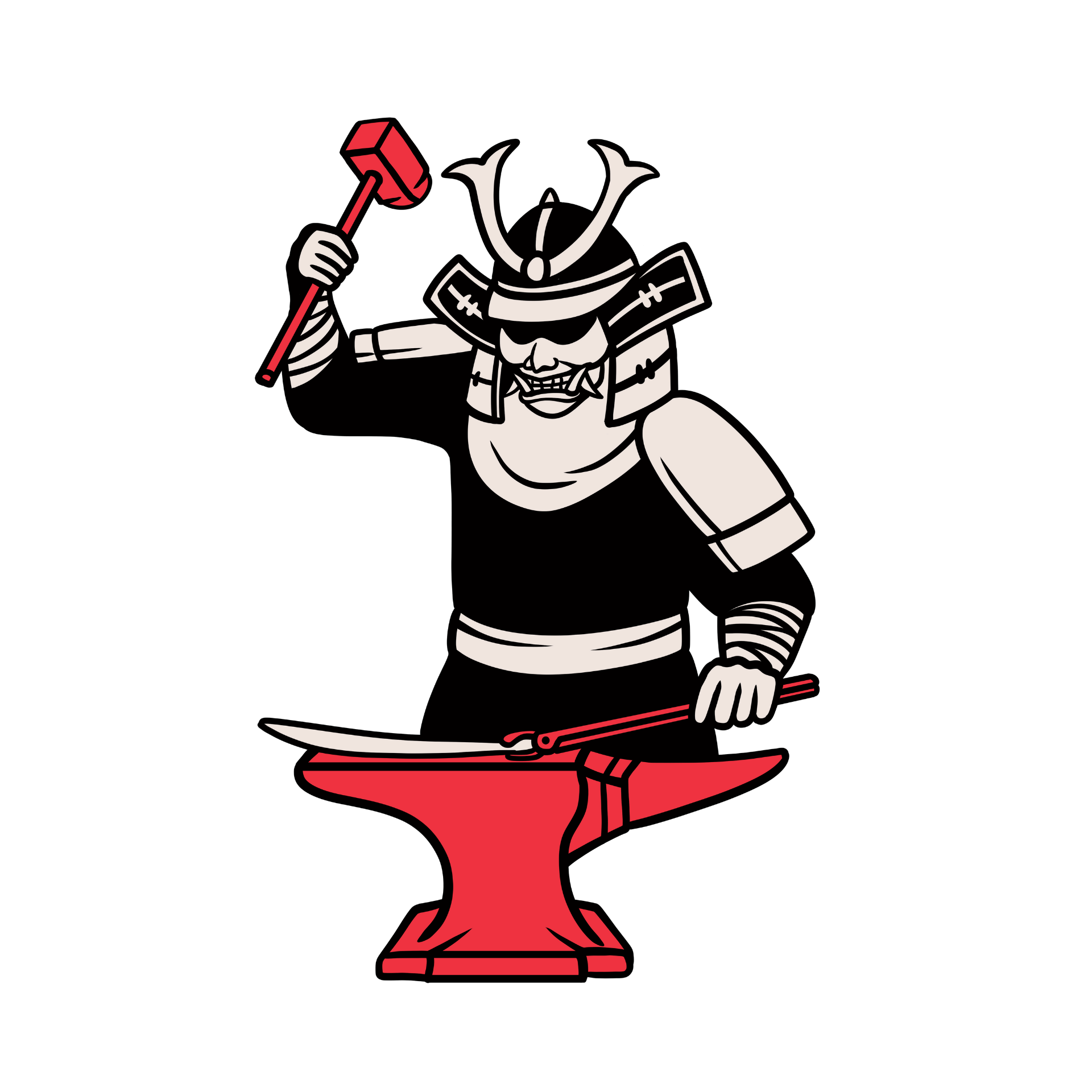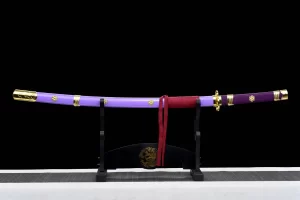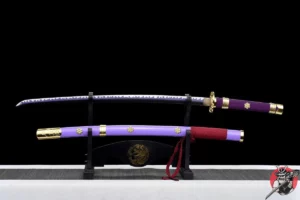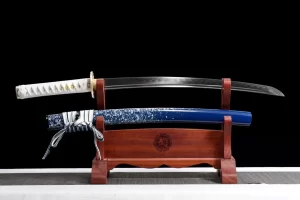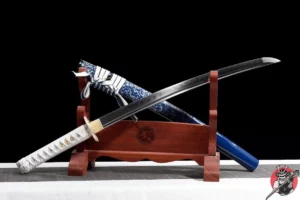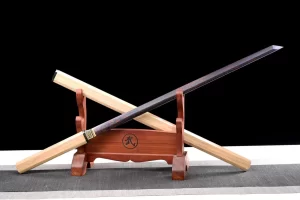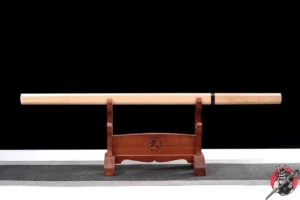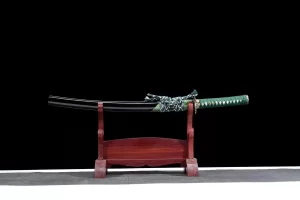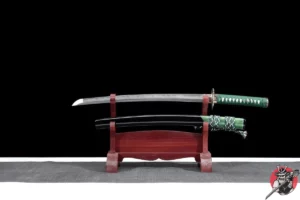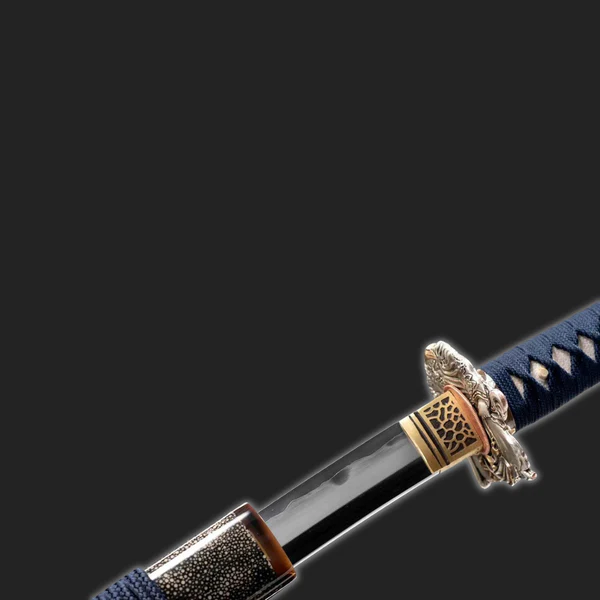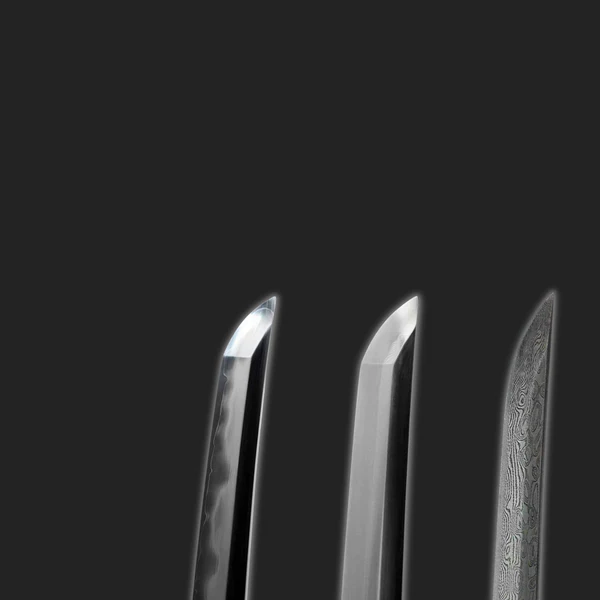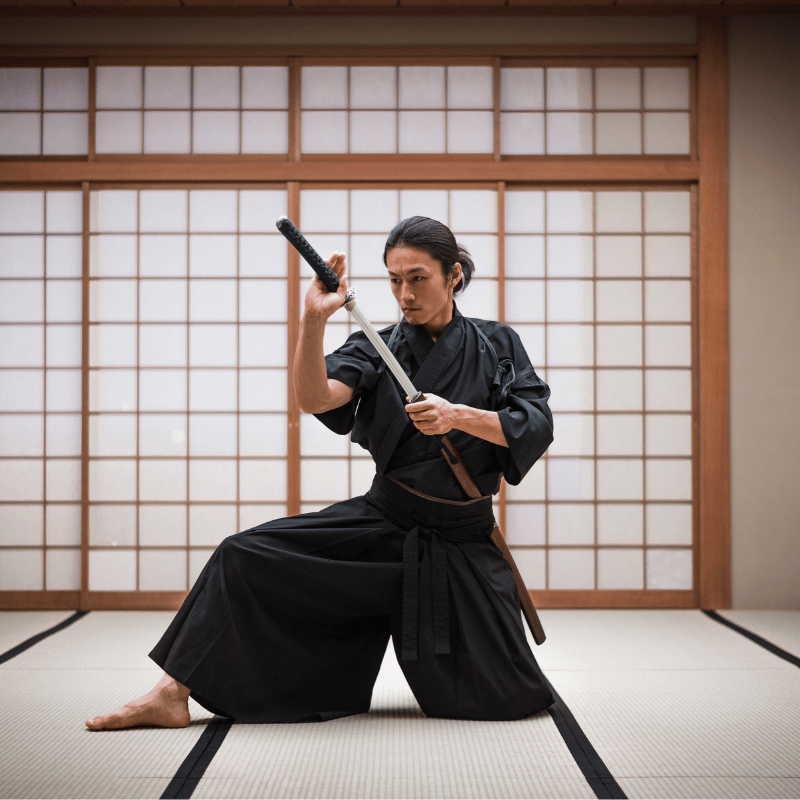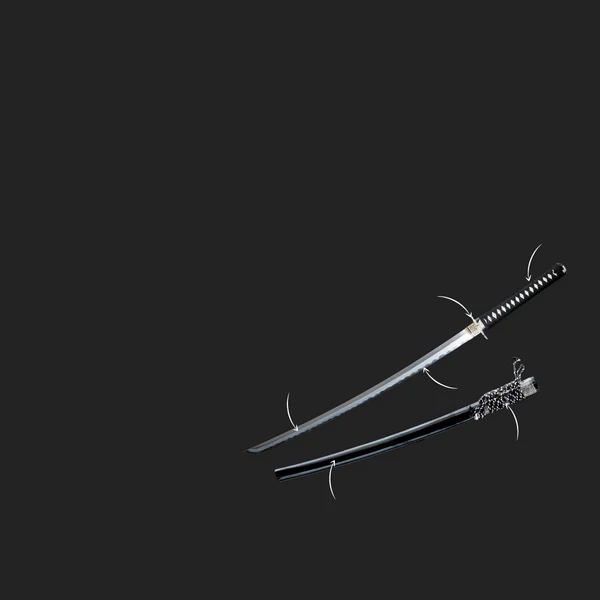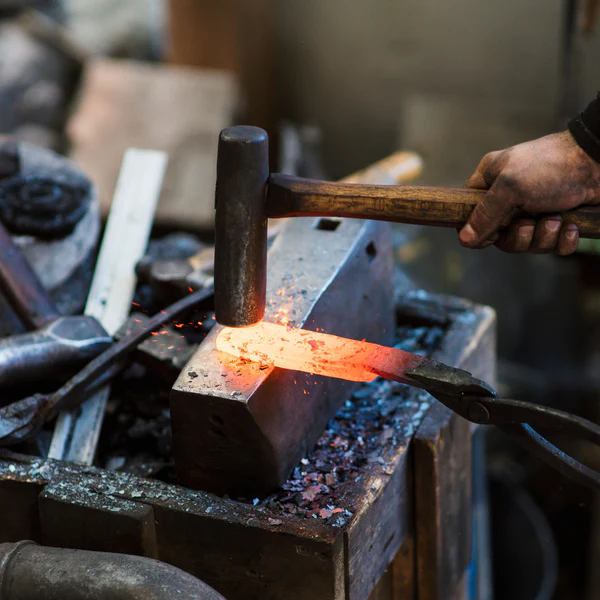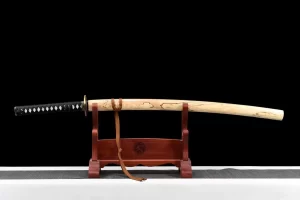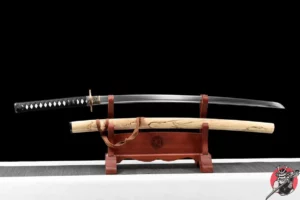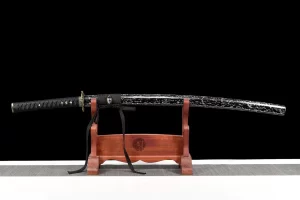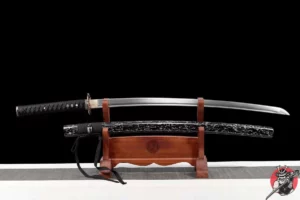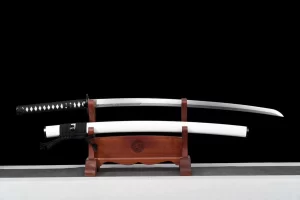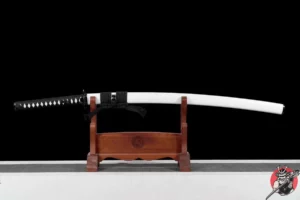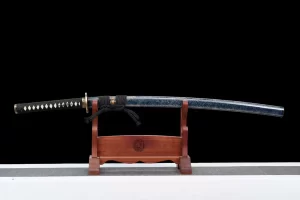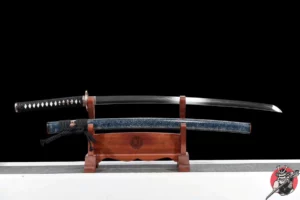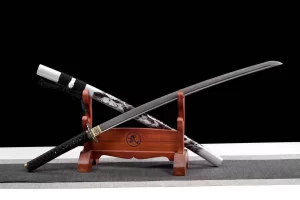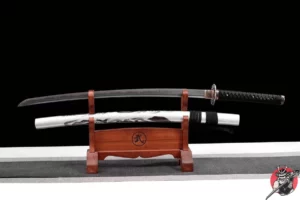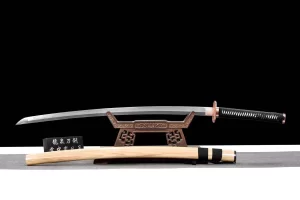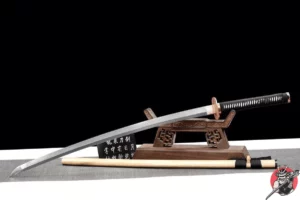🇯🇵 Heritage
A GENUINE HAND-FORGED KATANA
Crafted by master swordsmiths, guardians of a millennia-old heritage.
Katana Sword
Hand-forged Katanas by 18 master swordsmiths, preserving a timeless craft.
Custom Katana
Ready to take the next step and design your very own custom Katana? We offer a unique opportunity to craft every detail of your Japanese sword, from the blade to the scabbard, including the tsuka (handle) and all other components.
With our bespoke service, you have complete freedom to choose the materials, colors, patterns, specifications, and even the forging technique that best captures your vision.
Once you place your custom Katana order, our master artisans will receive your personalization details and begin the meticulous process of forging and assembling your sword. Every stage of your Katana’s creation is handled with precision and care, ensuring that your weapon is not only an extraordinary piece of craftsmanship but also a functional and durable blade.
Creating a custom Katana is about more than just owning a sword—it’s about crafting a personal masterpiece that embodies your style and passion. Let our skilled artisans bring your vision to life with a blade that is truly one of a kind.
New Katanas
Frequently Asked Questions
The Katana is a traditional Japanese sword, famously wielded by samurai during Japan’s feudal era. It’s defined by its single-edged, curved blade and a long, elegant handle designed for two-handed use. Renowned for its sharpness and meticulous craftsmanship, the Katana became a symbol of the warrior class, blending practical functionality with deep cultural significance.
The Katana stands out from other swords thanks to its unique shape, materials, and craftsmanship. Its curved blade is specifically crafted for swift, precise cuts, while the use of high-quality steel and traditional forging techniques give it exceptional sharpness and durability. This combination of design and function makes the Katana a truly one-of-a-kind weapon.
Today, Katanas are primarily valued as collectibles, decorative pieces, and are used in traditional Japanese martial arts like Iaido and Kendo. They’re also popular in historical reenactments. Keep in mind that owning and using Katanas may be subject to regulations depending on your country or region.
Proper Katana maintenance involves regularly oiling the blade, removing dust and impurities, and checking the saya (scabbard) and tsuka (handle) for any signs of damage, replacing parts as needed. It’s essential to use the right tools and oils specifically designed for Katana care, and for more extensive repairs or deep maintenance, it’s best to consult a specialist.
You can buy an authentic Katana from specialty retailers, online stores, or directly from traditional swordsmiths in Japan. When purchasing, it’s important to verify the sword’s origin, craftsmanship, and authenticity. Additionally, make sure you’re aware of any laws and regulations in your country or region regarding Katana ownership before making a purchase.
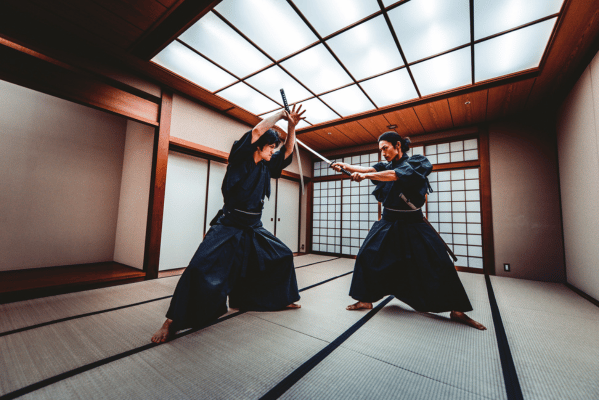
Real Katana
Our philosophy is simple: we offer only authentic Katanas, hand-forged by master swordsmiths in our own workshop. With decades of expertise in the ancient art of swordmaking, we provide genuine Katanas starting at just $200. In our online store, you’ll find a selection of Katanas crafted from Damascus steel, carbon steel, and traditional Japanese steels. All of our swords are designed in Japan and forged according to a tradition that spans over 2,000 years. Our passion for Katanas and Japanese culture drives us, and we’re thrilled to share this with you in the most authentic way possible through our website. If you’re looking to own a true Katana with all its defining features, you’ve come to the right place. Our carbon steel blades feature a clay-tempered hamon (temper line), a razor-sharp edge, and hand-engraved detailing, all crafted with precision and care.
Our KatanasSamurai Katana for Sale
Explore our extensive catalog of hundreds of unique, hand-forged Katanas, delivered straight to your door. We offer a wide selection of steel types, styles, forging techniques, and sizes, so you can find the Japanese sword that perfectly matches your vision. Choose from various types of steel, including T10 steel, 1065 steel, and 1045 manganese steel. For forging, we offer blades crafted using techniques like maru (single-layer), san-mai (three-layer), kobuse (soft-core), honsan-mai (true three-layer), and many other traditional methods. If you’re unsure which steel is right for you, we’ve created a detailed guide to help with your decision. Still can’t decide? Contact our team of experts, who are ready to help you find the perfect Katana. You can reach us via email, phone, or live chat. All of our Katanas are fully dismantlable, allowing you to appreciate each component of your sword—from the tsuba (guard) and habaki (blade collar) to the fuchi, kashira, and sageo (cord).
Our KatanasWelcome to Katana Sword, Your Ultimate Destination for Exceptional Japanese Swords
For over twenty years, we’ve had the privilege of offering an exclusive selection of Katanas that captivate enthusiasts and collectors worldwide. Renowned for their unmatched quality and authentic design, our blades have even received prestigious awards, a testament to our unwavering commitment to excellence.
Our swords are the result of a unique blend of tradition and artisanal craftsmanship. Designed according to ancient methods in Japan, they are hand-forged by our team of master swordsmiths in China. This meticulous, handcrafted process is carried out by a team of 18 experts, each specializing in traditional Japanese forging techniques. Their dedication and passion for this centuries-old art transform each sword into a true masterpiece, where precision and refinement come together to create Katanas of extraordinary quality.
At Katana Sword, we are committed to providing swords that embody the authenticity of Japanese tradition and the expertise of skilled craftsmanship. Whether you’re a seasoned collector or a newcomer eager to explore the fascinating world of Katanas, our range offers pieces that seamlessly blend elegance, power, and functionality.
Decorative Katana
A Katana is far more than just a weapon; it’s a symbol of Japanese culture. Owning a Katana for decorative purposes reflects a deep appreciation for Japan’s traditions, aesthetics, and history. Displaying a Katana in your home brings a piece of living history into your space, bridging the gap between the feudal Japan of the Edo period (1603-1868) and the modern world.
The Edo period, a time of relative peace under the Tokugawa shogunate, saw sword-making reach its peak. Katanas from this era are celebrated for their exquisite craftsmanship and unmatched beauty. Although samurai no longer fought daily battles, the Katana remained a symbol of status and honor, carried with pride and maintained with almost religious care.
Incorporating a Katana into modern interior design offers unique possibilities, each rich in symbolism and meaning. A traditional wall mount, known as tachi-kake in Japanese, elegantly showcases the blade’s graceful curvature and the intricate craftsmanship of the saya (scabbard). Mounted with the blade facing upward, this display represents vigilance and respect.
For those who prefer a horizontal presentation, a wooden stand, or Katana-kake, provides an authentic alternative. These stands, often crafted from fine woods like ebony or rosewood, can hold one or more swords, echoing the way samurai stored their weapons, ready for use. This arrangement allows full appreciation of the sword, from the tip (kissaki) to the handguard (tsuba) and the intricately woven handle (tsuka).
Selecting a decorative Katana is not a decision to be made lightly. Each piece tells a story and embodies a part of the Japanese spirit. The designs on the saya or tsuba open windows into Japan’s rich mythology and iconography. Common motifs include the dragon, symbolizing strength and wisdom; the cherry blossom (sakura), representing the fleeting beauty of life; and the geisha, a symbol of elegance and refinement.
Other, less common but equally meaningful motifs may adorn these decorative Katanas:
- The koi (carp), symbolizing perseverance and courage
- The tiger, representing strength and protection against evil
- The phoenix, a symbol of renewal and immortality
- The waves of Kanagawa, inspired by Hokusai’s famous print, symbolizing the power of nature
The choice of colors used in these decorations is equally significant. Red symbolizes passion and vital energy, black represents experience and wisdom, while gold evokes nobility and prosperity. These colors allow your Katana to harmonize with your interior decor while honoring traditional symbolism.
It’s important to note that these decorative Katanas, while faithful in appearance to historical swords, are generally not functional weapons. They’re crafted to be admired safely, preserving the essence and aesthetics of authentic Katanas without the practical dangers.
Purchasing a decorative Katana is more than just a transaction—it’s an immersion into Japanese culture, an invitation to contemplation and reflection. Each glance at the sword offers a moment to meditate on the values it represents: honor, respect, discipline, and the pursuit of perfection.
For those passionate about Japanese culture, owning such a piece becomes a rich source of conversation and connection. It offers the chance to explore the nuances of Japanese craftsmanship, discuss the fascinating history of the samurai, or simply admire the timeless beauty of an object that transcends its original function to become a true work of art.
Choosing a Katana as a decorative element brings a piece of Japan’s soul into your home. It creates a unique focal point in your space, an object that draws attention and sparks curiosity. More than just decoration, it’s an invitation to explore the rich, millennia-old culture of Japan that continues to captivate the world.
Katana Sword Price
The Katana, an enduring symbol of Japanese craftsmanship and the spirit of Bushido, has long captivated people around the world. For many enthusiasts, owning a Katana is more than just a purchase; it’s the fulfillment of a dream and a connection to the history and culture of feudal Japan. However, when it comes to buying a Katana, the question of price inevitably arises, and it’s essential to understand the factors that influence the cost.
At the high end of the spectrum, you’ll find exceptional Katanas—true masterpieces—whose prices can easily exceed $10,000. These one-of-a-kind pieces are painstakingly crafted by renowned master swordsmiths, using ancient techniques and the finest materials. Some of these Katanas may be decades old or even historical artifacts, which adds significantly to their value.
These high-end Katanas are distinguished by:
- A hand-forged blade made using the traditional tamahagane method, producing Japanese steel of exceptional purity.
- A lengthy manufacturing process, often taking months or even years to complete.
- Exquisite attention to detail, with precision finishing on every component.
- The use of premium materials, such as genuine ray skin for the handle and precious metals for the fittings.
- In some cases, a unique history or provenance, further enhancing the sword’s value.
However, we understand that such prices are beyond the reach of most enthusiasts. That’s why many manufacturers and retailers, like Katana Sword, offer more affordable alternatives without entirely sacrificing quality or authenticity.
In the $150 to $500 price range, you’ll find Katanas that, while not entirely hand-forged by a single master, still offer respectable quality and aesthetics faithful to traditional models. These Katanas are typically produced using a combination of artisanal and modern industrial techniques, allowing for lower costs while maintaining a satisfying level of craftsmanship.
Here’s what you can generally expect in this price range:
- $150 to $250:
- Blades made from medium-grade carbon steel or stainless steel.
- Basic yet well-crafted finishes.
- Tsuba (guard) and other fittings made from less expensive alloys.
- Saya (scabbard) crafted from standard-quality wood.
- Ideal for display or occasional practice
- $250 to $400:
- Blades made from higher-quality carbon steel, sometimes with heat treatment.
- More detailed finishes.
- Limited customization options.
- Higher-quality tsuba and fittings.
- Suitable for regular Iaido or Kenjutsu practice
- $400 to $500:
- Blades crafted from high-quality steel, often featuring a genuine hamon (temper line).
- Superior finishes.
- Tsuba and accessories made from higher-grade materials.
- Scabbard crafted from premium wood with more intricate finishes.
- Suitable for intensive practice and for discerning collectors
It’s important to note that even within these more affordable price ranges, each price increase generally reflects an improvement in materials and craftsmanship. A Katana priced at $500 will typically offer a better experience in terms of handling, durability, and aesthetics compared to a $200 model.
For those new to the world of Katanas or with a limited budget, entry-level models around $200 are an excellent starting point. While they may not match higher-end pieces in quality and authenticity, these Katanas still allow you to appreciate the beauty and essence of Japanese swordsmanship.
It’s essential to understand that these more affordable Katanas are not intended for intensive use or real combat. They are ideal for decoration, display, or light, controlled martial arts practice. For more demanding performance or cutting practice, it’s recommended to invest in higher-end models.
At Katana Sword, we offer a wide range of options to fit all budgets and levels of interest. Whether you’re a dedicated collector seeking a masterpiece, a serious martial artist, or simply someone looking for a beautiful decorative Katana, we have a sword that meets your needs and budget. The key is to choose a Katana that inspires you and allows you to fully appreciate this ancient art, whatever your approach.
Where to Buy a Katana
Katana-sword.us is the go-to shop for enthusiasts of authentic Japanese swords and Japanese history. If you’re looking to acquire a true Katana, forged using traditional methods, you’re in the right place. We offer a vast selection of hand-forged Katanas crafted by skilled artisans who uphold the age-old techniques that have made these legendary swords so renowned. Whether you’re a passionate collector, a martial artist, or simply an admirer of Japanese culture, you’ll find exceptional quality swords here that meet the highest standards.
Each piece is unique, embodying the essence of Japanese sword-making—a craft passed down through generations. With dozens of models available, ranging from decorative Katanas to fully functional combat swords, Katana-sword.us is the ideal destination to fuel your passion for these iconic weapons. We’re committed to offering a diverse range, from entry-level Katanas to high-end collector’s pieces, ensuring that everyone can find a sword that matches their desires and budget.
Katana Features
A Katana is more than just a weapon; it’s a true work of art, embodying centuries of craftsmanship and technical evolution. Over generations, master swordsmiths have perfected their skills to create swords of unparalleled precision and elegance. Every detail contributes to the balance, beauty, and effectiveness of this legendary blade.
Our Katanas stand out for the following features:
Hand-Forged Blade: Each blade is crafted from 1045 carbon steel, a material known for its strength and durability. Meticulously forged, it’s built to withstand the demands of combat while maintaining a refined, elegant finish.
Hardening and Durability: The blade is tempered to a hardness of 52 HRC on the Rockwell scale, ensuring a long-lasting sharp edge while maintaining enough flexibility to prevent breakage. This tempering achieves the ideal balance between strength and flexibility, essential for practical use.
Hand-Polished Finish: The blade is meticulously hand-polished, revealing its razor-sharp edge and a smooth surface that beautifully reflects light. This artisanal polishing enhances not only the Katana’s aesthetics but also its cutting performance.
Habaki and Seppa: The habaki (blade collar) is crafted from copper, ensuring a precise fit between the blade and the scabbard, while the seppa (spacers) in steel provide added strength and stability to the guard assembly.
Tsuba, Fuchi, and Kashira: The tsuba (guard) is crafted from steel, providing excellent hand protection while maintaining optimal balance. The fuchi (collar) and kashira (pommel) are made from brass and adorned with traditional motifs, adding both strength and elegance to the handle.
Tsuka and Ito: The tsuka (handle) is wrapped in genuine rayskin (same), a prized material known for its unique texture and durability. The ito (braid) is made from cotton and is carefully wrapped around the handle to provide a comfortable, secure grip—essential for proper handling of the sword.
Sageo and Menuki: The sageo (scabbard cord) is crafted from cotton, providing a sturdy and stylish attachment to the scabbard. The menuki (handle ornaments) made of brass add an elegant decorative touch while also enhancing the sword’s grip.
Kojiri and Kurikata: The kojiri (scabbard tip) is crafted from brass to protect the end of the saya (scabbard) and enhance its durability, while the kurikata (cord knob) in steel keeps the sageo securely in place, ensuring safe carrying.
Saya: The saya (scabbard) is crafted from wood and finished with a lacquered coating, providing elegant protection for the blade while enhancing the sword’s overall aesthetics. The cotton sageo matches the handle, completing the ensemble with refined style.
Authenticity and Legacy: Each Katana comes with a certificate of authenticity, guaranteeing its origin and quality. You will also receive a guide to bushido, the way of the samurai, immersing you in the values and philosophy that defined these legendary warriors.
Katana Blade
The blade is the most essential and defining feature of a Katana, with several specific characteristics that set it apart:
- Nagasa (長さ): The length of the blade.
- Sori (反り): The curvature of the blade.
- Kissaki (鋒): The tip of the blade.
- Mei (銘): The swordsmith’s signature engraved on the blade.
- Yasurime (やすり目): The file marks on the tang (the part of the blade hidden inside the handle).
- Horimono (彫物): Decorative engravings on the blade.
- Hamon (刃文): The temper line, indicating the blade’s differential hardening.
While there are many more intricate features that define a Katana blade, we focus here on the most important aspects to avoid overwhelming you with details. These key elements contribute to the blade’s performance, beauty, and historical significance.
1. Nagasa (長さ) – The Length of the Blade
The nagasa, a fundamental aspect of the Katana, varies significantly from sword to sword, with its selection closely tied to the wielder’s physique. The relationship between a swordsman’s height and the blade’s length is not just cosmetic—it directly impacts martial effectiveness and the overall harmony of the weapon.
For taller practitioners, over 180 centimeters, a longer blade—up to 85 centimeters—is often the most suitable choice. This extended length fully utilizes the user’s reach, offering an advantageous range while maintaining optimal balance.
Swordsmen of average height, typically between 165 and 175 centimeters, generally benefit from a blade length around 70 centimeters. This size strikes an excellent balance between maneuverability and reach, ensuring effective practice.
For individuals near 180 centimeters, a blade length between 74 and 75 centimeters is often ideal. This intermediate length provides enhanced range without sacrificing the agility needed for executing complex techniques.
It’s important to remember that these guidelines are flexible rather than strict rules. Each practitioner should refine their choice based on combat style, physical strength, and personal preferences. A well-fitted Katana becomes an extension of the body, enhancing fluidity of movement and martial efficiency.
2. Sori (反り) – The Curvature of the Blade
The sori, far from being just an aesthetic feature, plays a crucial role in the Katana’s performance. This distinctive curve, refined over centuries, reflects the sword’s adaptation to the changing needs of Japanese warriors.
There are several types of sori, each offering different advantages:
Muzori (無反り): Meaning “no curvature,” this straight blade is rare in Katana history. While it offers excellent accuracy in thrusting techniques, it sacrifices cutting power.
Chūzori (中湾反り): This moderate curve strikes a balanced compromise between offensive and defensive capabilities, allowing for effective cutting techniques while maintaining solid thrusting ability.
Sakizori (先反り): Featuring a pronounced curve toward the tip, this shape favors quick, precise cuts, making it particularly effective in close-quarter combat.
Koshizori (腰反り): With the curve emphasized near the handle, this shape provides exceptional cutting power, though it sacrifices some accuracy in thrusting.
The evolution of these curvatures throughout Japanese history reflects shifts in combat techniques and armor development. Experts in nihonto (Japanese swords) can often estimate a blade’s age by analyzing its curvature, underscoring the deep historical and technical significance of this martial art.
3. Kissaki (切先) – The Tip of the Blade
The kissaki, or tip of the Katana, is much more than a sharp endpoint. Its shape and length have been refined through centuries of evolution, with each variation reflecting the tactical needs and aesthetic preferences of different historical periods.
One of the most common types is the chū-kissaki (中切先), or medium tip. Originating in the Kamakura period (1185-1333), this balanced shape provides an excellent compromise between piercing ability and durability. Its development coincided with advancements in combat techniques and armor, requiring a point capable of effectively penetrating armor while withstanding impact.
Other notable kissaki types include:
O-kissaki (大切先): This large tip, common in the late Heian and early Kamakura periods, offers a larger cutting surface but is more prone to fragility.
Ko-kissaki (小切先): Smaller and more robust, this tip was prevalent during the Koto period (pre-1596), offering better resistance to frontal impacts.
Ikubi-kissaki (猪首切先): Known as the “boar’s neck” tip, this rare style features a pronounced curve and a highly tapered point, giving it exceptional piercing capabilities.
The shape of the kissaki not only influences the Katana’s offensive potential but also affects its overall balance and aesthetics. Experts can often date a blade and attribute it to a particular school of swordsmithing by analyzing the details of its kissaki.
4. Mei (銘) – The Swordsmith’s Signature
The mei, or signature of the master swordsmith, is more than just an identifier. It represents the artisan’s honor and pride, etched into the metal as a testament to their craftsmanship. Traditionally engraved on the tang (nakago) of the Katana, the mei is created using a hammer and chisel, requiring both precision and skill.
A mei can include various details:
- The name of the swordsmith or the forging school
- The date of creation, often using the traditional Japanese calendar
- The location where the sword was forged
- Dedications or religious inscriptions
For collectors and historians, the presence and quality of the mei are highly important. An authentic and well-preserved mei can greatly enhance both the historical and monetary value of a Katana, offering invaluable insights into its origin and the context of its creation.
5. Yasurime (鎬目) – File Marks
The yasurime, often overlooked by newcomers, holds valuable information for those who understand its significance. These file marks, made on the tang (nakago) of the Katana, are not merely finishing touches but a coded language of sorts.
The yasurime process takes place after the blade has been forged. The swordsmith uses a special file to even out the tang’s surface, creating a textured pattern that improves the grip of the tsuka (handle) and prepares the area for the inscription of the mei.
Different styles of yasurime include:
- Katte-sagari: Diagonal lines descending toward the tip
- Kiri: A pattern resembling a paulownia leaf
- Sujikai: Crossed diagonal lines
- Kesho: A smooth surface with no visible marks
Each school of swordsmithing—and often individual swordsmiths—had unique yasurime styles. For experts, these marks can be as revealing as the mei itself, offering valuable clues about the Katana’s origin and the period of its creation.
6. Horimono (彫物) – Blade Engravings
The art of horimono, or blade engraving, goes beyond decoration, serving as a symbolic and spiritual language on the Katana. These engravings, often crafted by specialists separate from the swordsmiths, add personal and spiritual significance to the sword.
Common motifs include:
- Hi (樋): A groove running along the blade, designed to reduce weight without compromising strength.
- Bonji (梵字): Sanskrit characters representing Buddhist deities.
- Kurikara (倶利伽羅): A dragon coiled around a sword, symbolizing strength and wisdom.
- Suken (素剣): A stylized sword, often associated with warrior deities.
These engravings serve several purposes:
- Protective Talisman: Many motifs are believed to bring good luck, ward off evil, and protect the Katana’s wielder.
- Personal Expression: The choice of designs often reflects the samurai’s clan, beliefs, or social status.
- Aesthetic Value: These engravings add an artistic element to the Katana, transforming it into a wearable work of art.
It’s important to note that creating horimono is an extremely delicate process. The artisan must engrave the blade without compromising its structural integrity, requiring a high level of skill and precision.
7. Hamon (刃文) – The Temper Line
The hamon, a signature feature of the Katana, is more than just an ornamental line. This wavy mark along the blade is the result of differential hardening, a sophisticated forging technique that gives the Katana its legendary qualities.
During the tempering process, the swordsmith applies a layer of clay to the blade—thicker on the spine and thinner on the cutting edge. When the red-hot blade is plunged into cold water, this differential cooling creates areas of varying hardness. The edge, cooling more quickly, becomes incredibly hard and sharp, while the spine, cooling more slowly, retains flexibility, preventing the blade from breaking.
The resulting hamon is not just aesthetic; it’s a visible testament to this intricate process. Some of the most famous hamon styles include:
- Suguha: A straight line, representing the elegant simplicity of certain schools.
- Notare: A gentle wave pattern, reminiscent of ocean waves.
- Gunome: A series of regular half-circles, evoking the image of clouds.
- Midare: An irregular, chaotic pattern, showcasing the swordsmith’s absolute mastery.
Certain hamon patterns have become legendary and are associated with famous swordsmiths:
- Masamune Hamon: Known for its subtlety and elegance, reflecting the unparalleled skill of Goro Nyudo Masamune.
- Kotetsu Hamon: Recognizable by its distinctive “fish scale” pattern, the signature of master swordsmith Nagasone Kotetsu.
Interpreting the hamon is an art in itself, allowing experts to identify not only the school of swordmaking but also the specific conditions under which the blade was crafted. A genuine hamon, resulting from true differential tempering, is easily distinguished from purely decorative lines found on modern replicas.
Each of these seven elements—nagasa, sori, kissaki, mei, yasurime, horimono, and hamon—come together to make the Katana much more than just a weapon. It is a living testament to the history, spirituality, and craftsmanship of Japan, where every detail tells a story and embodies centuries of tradition and innovation. Mastery of these aspects allows one to truly appreciate not only the beauty of the Katana but also the depth of the culture that created and shaped this iconic sword.
Components of a Katana
The Katana, the legendary sword of the samurai, is much more than a weapon of war. It is a masterpiece of precision, a perfect harmony of aesthetics and functionality. Every part of the Katana is meticulously designed, crafted, and assembled to achieve ideal balance in both handling and appearance. Explore the intricate details of this iconic blade and discover why the Katana remains an enduring symbol of martial arts and Japanese culture.
Sori (反り): The sori refers to the curvature of the blade, a key feature that impacts both the maneuverability and effectiveness of the Katana. This curve is not merely decorative; it enhances the fluidity of cuts, especially in quick-draw techniques (iai). Katanas with more pronounced curves, like sakizori (curved toward the tip), facilitate swift strikes, while gentler curves like koshizori (curved near the handle) offer better control. Each type of sori corresponds to specific historical periods, reflecting the evolution of combat styles over time.
Shinogi & Shinogi-Hi: The shinogi is the ridge running along the blade, separating the cutting edge from the spine. This structural line is crucial for the strength and balance of the Katana. The shinogi-hi is an optional groove, often carved parallel to the shinogi, designed to lighten the blade without sacrificing durability. This groove also helps concentrate energy during cuts and enhances the sword’s balance, producing a distinctive sound when a cut is executed correctly—a highly valued feature in martial arts practice.
Hamon (刃文): The hamon is the visible temper line that marks the boundary between the hardened and softer areas of the blade. It is one of the most prized features in Katana craftsmanship, as each hamon is unique. This temper line is created through differential hardening, revealing wave-like or straight patterns. A well-executed hamon reflects the swordsmith’s expertise, providing a hard cutting edge while allowing flexibility in the spine, which ensures the blade’s durability in combat.
Boshi (帽子): The boshi is the continuation of the hamon at the tip (kissaki) of the blade. Proper polishing of this area is crucial, as the strength and sharpness of the kissaki depend on this treatment. A well-defined boshi ensures that the tip remains hard and resistant to chipping, even under intensive use. It’s also a key detail for experts, as a finely crafted boshi indicates a high-quality blade.
Yokote (横手): The yokote is the line that separates the main blade from the tip (kissaki). This division is essential for distinguishing the functional parts of the Katana. The yokote helps maintain control during cuts with the tip. While some modern blades lack a distinct yokote, traditional Katanas often feature this clear separation, making them more aesthetically and technically true to historical models.
Kissaki (切先): The kissaki is the tip of the Katana. Its size and shape vary depending on the era and fighting style. An o-kissaki (long tip) is more aggressive, designed for deep and fast cuts, while a ko-kissaki (short tip) is more robust and suited for close combat. A well-polished tip is crucial for maximum effectiveness, as the kissaki is frequently used in finishing techniques.
Ha (刃): The ha is the cutting edge of the blade, the component that defines the Katana’s effectiveness in combat. The quality of the ha largely depends on the tempering process and the type of steel used. Traditionally, the edge is hardened to ensure sharp, precise cuts while resisting wear. A well-maintained ha can retain its sharpness for years, but it requires regular polishing to stay in peak condition.
Bo-Hi (棒樋): The bo-hi is a groove carved into the blade with two main purposes: reducing weight and adjusting balance. By lowering the weight without compromising strength, the bo-hi allows for quicker, more fluid movements. It also enhances the distinctive sound produced during a successful cut, a feature highly valued in martial arts like iaido.
Nakago (茎): The nakago is the tang of the blade, the part hidden inside the handle (tsuka). Although invisible, the nakago is essential to the Katana’s strength. A well-forged tang ensures the blade won’t break during use. Additionally, the nakago is often signed by the swordsmith, helping to authenticate the blade and trace its origins.
Saya (鞘): The saya is the scabbard that houses the Katana. Made from lacquered wood, it is crafted to protect the blade while allowing for a quick, smooth draw. The fit of the saya is essential, as it must secure the blade without causing any damage. Decorations on the scabbard, such as dragons, flowers, or landscapes, often reflect the samurai’s identity and rank.
Shiadome & Kurigata: The shiadome is a metal fitting on the scabbard that secures the sageo, a silk or cotton cord. The kurigata is a small attachment through which the sageo is threaded. Together, these components allow the Katana to be fastened to the practitioner’s belt, combining functionality with aesthetic appeal.
Sageo (下緒): The sageo is the cord that secures the Katana to the practitioner’s belt (obi). The color and material of the sageo are often matched to the tsuka-ito (handle cord) for visual harmony. Traditionally, the sageo is also used to secure the sword when it is sheathed.
Habaki & Seppa (鎺 & 切羽): The habaki is a metal collar that holds the blade securely within the scabbard and aids in the draw. It also enhances the sword’s overall strength by absorbing some of the shock during use. The seppa are small washers that fill the space between the tsuba and the handle, ensuring a precise fit and evenly distributing vibrations.
Tsuba (鍔): The tsuba is the guard positioned between the blade and the handle, protecting the user’s hand. Often richly decorated, it features designs inspired by nature, mythology, or clan emblems. Beyond its protective role, the tsuba also influences the sword’s overall balance.
Fuchi (縁): The fuchi is a metal ring that reinforces the joint between the handle and the blade, enhancing the weapon’s durability. Often engraved with intricate patterns, it also conceals the ends of the tsuka-ito, providing a seamless finish.
Tsuka-Ito (柄糸): The tsuka-ito is the cord wrapped around the handle. Traditionally made from cotton, silk, or leather, it is wrapped in a way that provides a firm, comfortable grip while adding an elegant visual touch. The wrapping must be precise to prevent slipping during use.
Same (鮫皮): The same is the rayskin or sharkskin used beneath the tsuka-ito. It provides a rough texture that enhances grip, preventing the handle from slipping, while also adding extra durability to the handle.
Mekugi (目釘): The mekugi are wooden or bamboo pegs that secure the handle to the tang of the Katana. Traditionally, two mekugi are used to ensure the sword’s stability, although some Katanas use only one. Regular replacement of the mekugi is necessary to maintain safety during use.
Menuki (目貫): The menuki are decorative ornaments placed beneath the tsuka-ito, adding both aesthetic appeal and ergonomic comfort to the grip. Often made from copper or brass, these decorations frequently depict symbols or stories connected to Japanese culture.
Kashira (頭): The kashira is the pommel at the end of the handle, usually matching the fuchi to create visual harmony. It is often decorated with motifs that complement the Katana’s overall aesthetic while also reinforcing the handle.
At Katana-sword.us, we offer a wide range of Katanas that honor this exceptional heritage, crafted with quality materials and traditional techniques. Whether you are a collector, practitioner, or simply a lover of Japanese culture, our Katanas are selected to meet your expectations for authenticity, beauty, and performance.
What is the Best Steel for a Katana?
The most renowned and sought-after steel for crafting a high-quality Katana is undoubtedly tamahagane. This rare, traditional steel is prized for its exceptional properties, particularly its high carbon content, which is essential for producing a blade that is strong, sharp, and flexible. The challenge in forging a Katana lies in achieving the perfect balance between these qualities: a blade that is too hard may become brittle and break, while one that is too soft could lose its edge. This is where tamahagane excels.
The process of creating tamahagane is as impressive as it is complex. This steel is produced in traditional furnaces called tatara, where iron sand is heated over several days at high temperatures. Master swordsmiths carefully select pieces of metal based on their carbon content to create the ideal steel for a Katana. The tamahagane is then repeatedly hammered and folded—often up to 15 times—to remove impurities and evenly distribute the carbon throughout the blade.
Each fold in the steel creates layers that not only strengthen the Katana’s structure but also produce the distinctive patterns seen on the blade, known as hada. This pattern is one of the visual hallmarks of a Katana forged in the purest Japanese tradition. This labor-intensive process requires exceptional skill and considerable time, which is why Katanas made from tamahagane are so rare and valuable.
Furthermore, the production of tamahagane is strictly regulated in Japan, making it even rarer and more coveted. Only a select number of certified swordsmiths are permitted to produce this steel, limiting its availability on the international market. Each blade forged from tamahagane is a unique piece, imbued with the history and ancestral craftsmanship of Japan’s master swordsmiths.
If you’re seeking a Katana of superior quality, offering both exceptional cutting performance and unparalleled artisanal heritage, tamahagane is the most prestigious and sought-after choice.
Buy Katana
Katana-sword.us is your ultimate destination for authentic Japanese swords and Katanas. Explore our expertly curated selection of hand-forged Katanas, crafted by master artisans to ignite your passion for these legendary weapons. Whether you’re a collector, martial artist, or enthusiast of Japanese culture, our range offers the perfect balance of tradition, craftsmanship, and performance.
Katana Maintenance
To keep your Katana in optimal condition and ensure its longevity, it’s essential to follow specific care and maintenance steps. Here are our recommendations for preserving your sword:
Wipe the blade after each use: Use a soft, non-abrasive cloth to remove any dust, moisture, or oil left on the blade after handling. This simple step helps prevent stains and rust.
Store the Katana in a cool, dry environment: Keep your Katana in a low-humidity environment, as excessive moisture can cause rust. Avoid extreme temperatures, which could damage the handle or guard.
Handle your Katana with care: Never twist or bend the blade, as this could cause irreversible damage to the steel. The Katana is designed for smooth, straight movements, and any attempt to bend it could weaken the blade’s structure.
Avoid impacts with hard surfaces: Be careful not to drop your Katana or let it come into contact with hard objects. Impact on rigid surfaces can chip or damage the blade or affect its edge alignment.
Regularly sharpen the blade: To maintain a sharp edge, sharpen the blade occasionally, especially if it’s used frequently. Use proper sharpening stones, or if you’re not experienced, entrust this task to a qualified professional.
Leave repairs to a master swordsmith: For complex repairs, such as chips, cracks, or alignment issues, it’s essential to consult an experienced swordsmith. Only a skilled professional can repair the Katana without compromising its integrity or cutting ability.
Regular maintenance not only ensures the durability of your Katana but also honors the craftsmanship of the swordsmiths who created it. By caring for your Katana, you preserve its beauty and performance for many years to come.
The Origin of the Katana
The Katana (かたな in hiragana) is one of the most iconic weapons in Japanese history. This curved, single-edged sword, typically over 60 cm in length, was perfected over centuries to meet the demands of the samurai, Japan’s elite warrior class.
The Katana first emerged during the Muromachi period (1336-1573) and soon became the weapon of choice for the samurai, gradually replacing the longer, more curved tachi. Its popularity continued to grow during the Edo period (1603-1868), when it played a central role in samurai culture and identity. Worn at the waist in a style known as daisho (大小), the Katana was often paired with a shorter sword, the wakizashi, symbolizing the samurai’s rank and status.
What sets the Katana apart is not only its elegant shape and subtle curvature but also the complexity of its creation. Forged from tamahagane steel, the Katana was designed to be incredibly sharp and durable, while also maintaining a degree of flexibility. This balance made it a formidable weapon, capable of precise cutting while withstanding the rigors of intense combat.
Beyond its function as a weapon, the Katana held deep spiritual and symbolic meaning. It was considered the soul of the samurai and was exclusively worn by members of this noble class. Whether in battle or ceremonial contexts, the Katana was a constant companion, often passed down through generations as a treasured family heirloom.
During the Edo period, samurai carried their Katanas at all times, secured to their belts (obi), ready to be drawn in an instant through the technique of iaijutsu. The speed of this technique, combined with the blade’s precision, made the Katana a weapon equally suited for offensive and defensive maneuvers.
Today, the Katana remains an enduring symbol of Japanese culture. Its legacy lives on through the art of swordsmithing and martial arts such as kendo and iaido, which continue to preserve the spirit and techniques of these ancient warriors.

